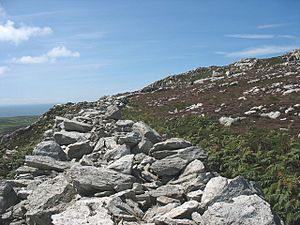Caer y Twr facts for kids
Caer y Twr (which means Tower Fortress in Welsh) is an ancient hillfort from the Iron Age. It sits high up on the top of Holyhead Mountain in Anglesey, Wales.
Contents
Discovering Caer y Twr
Caer y Twr is a fascinating historical site. It was built a very long time ago, during the Iron Age. This was a period when people used iron tools and weapons.
What is a Hillfort?
A hillfort is a type of fort built on a hill. People in the Iron Age often chose high places. This made it easier to defend against enemies. Caer y Twr is a great example of this. It is surrounded by rocky areas, making it naturally strong.
Why Was Caer y Twr Built?
Experts believe Caer y Twr was a very important place. It was likely used as a lookout point. From its high position, people could see far across the land and sea.
It might have been a watchtower, keeping an eye out for danger. Some think it was a signal tower. This means people could light fires or use other signals to warn others. For example, it might have warned a smaller fort in Holyhead about raiders coming from the Irish Sea.
Another idea is that Caer y Twr could have been an early type of lighthouse. It would have guided ships safely along the coast.
What Caer y Twr Looks Like Today
Today, Caer y Twr is mostly made of fallen stones and rubble. But you can still see where its strong walls once stood. On the north and east sides, there is a large stone wall. In some places, this wall is still 3 metres (about 10 feet) high!
The main way into the fort was through a narrow, rocky path. When archaeologists dug at the site, they found the base of a tower. The stones from this tower are thought to be from the 2nd to the 4th centuries. This shows the fort was used for a long time.
Homes Near the Fort
Just below Caer y Twr, there is another interesting site. It is a group of old enclosed huts called Cytiau Tŷ Mawr. This means "Great House Huts" in Welsh. These huts are also from around the 3rd to 4th centuries.
Some of these ancient homes still have parts of their original features. You can see old hearths (fireplaces) where people cooked. There are also shelves where they kept their belongings. These huts show us how people lived near the fort long ago.


